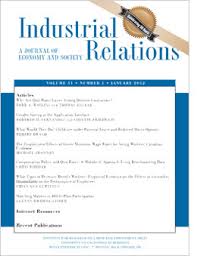The relationship between employer and employee or trade unions is called Industrial Relation (IR). Harmonious relationship is necessary for both employers and employees to safeguard the interests of both parties of the production. In order to maintain good relationship with the employees, the main functions of every organization should avoid any dispute with them or settle it as early as possible so as to ensure industrial peace and higher productivity. In other words, good Industrial Relation means industrial peace which is necessary for better and higher productions. IR may be understood in both inter and intra terms-that is between employers and employees, between employees and employees and also between employers and employers. Such diverse relations are the outcome of modern industrial production, entailing an enormous body of collective work and involving the corporate labour of a huge number of people in an enterprise. Of all these relations, however the one between employers and employees is of paramount importance under the system of capitalist relations of production. Some authors define the term industrial relations also as either the full range of rule governing the work place (Dunlop, 1958), or a study of the institutions for job regulations (Allen,1975) or even the maintenance of stability and regularity in industry (Richard,1981)
IR is also concerned with determination of wages and conditions of employment. IR and human relations are distinctly two indispensable factors in industry, one depending on the other. We can have good industrial relations in an industry, but bad human relations in the same establishment and vice versa. Good industrial relations provide the necessary background for human relations. In any undertaking, good relations between the management and workers depend upon the degree of mutual confidence which can be established. This, in turn, depends upon the recognition by the employees of the goodwill and integrity of the management in the day-to-day handling of questions, which are of mutual concern. The first requisite for the development of good industrial relations is a good labour policy. The aim of such a policy should be to secure the best possible co-operation of the employees. Every employee should have the opportunity to contribute not only his services, but also his suggestions and ideas towards the common effort.
The basic needs of an industrial worker are freedom from fear, security of employment and freedom from want. Adequate food, better health, clothing and housing are human requirements. The human heart harbors secret pride and invariably responds to courtesy and kindness just as it revolts to tyranny and fear. An environment where he is contented with his job, assured of a bright future, and provided with his basic needs in life means an atmosphere of good IR.
IR has several roles in the industrial development in any country; two fold objectives of good industrial relations are to preserve industrial peace and to secure industrial-operations. If we have to establish industrial peace, the workers must be assured of fair wages, good conditions of work, responsible working, holidays and minimum facilities of life. The objectives of good industrial relations should be the development and progress of industry through democratic methods, stability, total well-being and happiness of the workers, and industrial peace. Hence, industrial peace is the fruit of good industrial relations.
Background of the Research
The export-oriented apparel industry of Bangladesh, popularly known as readymade garment (RMG) or simply the garment industry occupies a unique position in economy of
Bangladesh. It is the largest exporting industry, which experienced a phenomenal growth
during the last three decades. By taking advantage of cheap labor and quota-based market in the USA and EU under the provision of Multi Fiber Arrangement (MFA) of GATT, it
attained a high profile in terms of economic growth of the country. The industry started its modest journey in late 1970s and enjoyed a meteoric rise from 30 enterprises in 1980
increased to 4825 in 20081. Average growth rate of this sector was over 20% per over the last two decades. This single sector alone earns about 80% of yearly foreign exchange of the country. Its contribution to GDP reaches 13% in fiscal year 2009-2010. Since independence, no single sector could accelerate the industrialization process in the country as the RMG sector could do. It has created employment opportunity for about 3.5 million people. Most of them are uneducated and unskilled. About 80% of them are women. To a creditable extent, it has been able to relieve the country from the burden of unemployment and at the same time contribute to the empowerment of women. Thus this sector is playing a vital role in socioeconomic development of the country.
But this sector is struggling with a number of problems. Conflict between owners and workers, labor unrest, shortage of gas and electricity, poor infrastructure, poor port facility, lead time complexities, conspiracy of home and abroad, advancing competitors in the quota free international market are some of them which are posing a great threat to its survival. In recent time, labor unrest in the RMG sector has been a matter of serious concern. Almost every day electronic and print media cover news of labor unrest in RMG sector in one place or another across the country. Fixing new minimum wage for the garment workers and issue of implementing the new wage structure have been the prime causes of recent labor unrests across the country. The unrest takes shape of violence and vandalism. The agitated workers come to the street and go storming on vehicles and garment factories. The attacked factory is 1 Source: BGMEA website declared closed; many labor leaders are arrested, many workers lose jobs or suffer from uncertainty; losing interest in the uncertainty, the international buyers cancel their orders and divert to another market. The industry comes to a deadlock situation. The growth of RMG sector in Bangladesh is amazing one and it has been possible mainly because of hard work of labor-force. Rashid, (2010) observes, “It is a story of success, of winning against all odds. It is a story of a nation, which has vowed to overcome all the barriers with limited resources and immense passion. It is not a story of “Veni Vidi Vici2.” Rather, it is a tale of toil, a tale of rising, of starting small and finally finding glory”. But this glory is being diminished day by day due to labor unrest in this sector. This study is designed to unearth the causes of labor unrest and search the areas where Public-Private Partnership can work to address the problem.
Statement of topic
There are, mainly, four parties involved in apparel industry: government, factory owners,
international buyers of finished garments, and workers. Of four parties, the first three are immense beneficiaries, while workers remain deprived. Government receives a handsome
amount of revenue from this sector. Buyers, who get garment products at the cheapest possible price, make huge profits in international markets. Most of the local factory owners make adequate money out of this business to build palatial houses in posh area of capital, have their children educated and treated abroad, ride luxury cars, spend holidays at tourist resorts across the world. But garment workers, who make all these profits and benefits possible for other three parties, are to live a sub-standard life for years. The wage they get is low. Very often they do not get their salary, overtime bills and bonus in time. Their recruitment system is hiring and firing as they do not get any appointment letter and at any time they can be dismissed by owners for any reason. Being maltreated by owners and midlevel officers, working long hours in a congested room without sufficient rest, lack of recreational opportunity, nutritious foods, medicine, right to legitimate protest against ruthless exploitations, etc are their daily destiny. They don’t have any access to the decision making process. Factory building collapse, fire accident, stampede render many dead and 2 A Latin sentence reportedly written by Julius Caesar in 47 BC meaning easy triumph 3 injured. Nevertheless, if any worker protests against owners or management, he/she is threatened by various types of harassment such as dismissal, arrest or even physical assault by the hired hooligans of owners. There are allegations that a vested group is behind the violence in garments industry. Some Human-right-based NGOs are alleged to instigate the work-force in the name of their rights and privileges without knowing the actual capacity of the owners. Very often, agitating workers are aided by outsiders. Nowhere in the world is labor as cheap as in Bangladesh. It is one of the main factors for flourishing of this sector in Bangladesh. Therefore, foreign conspiracies in instigating labor unrest in garment sector of Bangladesh cannot be ruled out as history records hundreds of wars to capture another market. At every incidence of labor unrest, police is deployed to disperse agitators. The coercive measures of the forces rather deteriorate the situation. Concerned groups engage themselves in blame game and do not waste time to put their readymade comments. Party in power always takes it as a subversive act of opposition party to destabilize government. Opposition party labels it as a failure of government and demands resignation. Factory owners blame workers and vice-versa. Very often, after some violent unrest, an inquiry committee is formed to look into the fact. But the fact is that, hardly people come across the investigation report. After some days people forget the issue and things go on as usual. Solving labor unrest in the RMG sector requires a collective effort. The root causes of unrest are to be explored. If private sectors (garment factory owners, managers, workers, BGMEA, workers’ association, members of civil society organizations, NGO activists) with their firsthand knowledge and experience work together with the public bodies, solution of this problem is possible.
Objectives of the study
I) To find out the causes of labor unrest in RMG sector of Bangladesh
II) Can public-private cooperation help address labor unrest in the RMG sector of
Bangladesh
III) To identify areas where public and private sector work together to solve the problem
Concepts involved
The export-oriented apparel industry of Bangladesh, popularly known as readymade garment (RMG) or simply the garment industry occupies a unique position in economy of Bangladesh. It is the largest exporting industry, which experienced a phenomenal growth during the last three decades. By taking advantage of cheap labor and quota-based market in the USA and EU under the provision of Multi Fiber Arrangement (MFA) of GATT, it attained a high profile in terms of economic growth of the country. The industry started its modest journey in late 1970s and enjoyed a meteoric rise from 30 enterprises in 1980 increased to 4825 in 20081. Average growth rate of this sector was over 20% per over the last two decades. This single sector alone earns about 80% of yearly foreign exchange of the country. Its contribution to GDP reaches 13% in fiscal year 2009-2010. Since independence, no single sector could accelerate the industrialization process in the country as the RMG sector could do. It has created employment opportunity for about 3.5 million people. Most of them are uneducated and unskilled. About 80% of them are women. To a creditable extent, it has been able to relieve the country from the burden of unemployment and at the same time contribute to the empowerment of women. Thus this sector is playing a vital role in socioeconomic development of the country.
But this sector is struggling with a number of problems. Conflict between owners and workers, labor unrest, shortage of gas and electricity, poor infrastructure, poor port facility, lead time complexities, conspiracy of home and abroad, advancing competitors in the quota free international market are some of them which are posing a great threat to its survival. In recent time, labor unrest in the RMG sector has been a matter of serious concern. Almost every day electronic and print media cover news of labor unrest in RMG sector in one place or another across the country. Fixing new minimum wage for the garment workers and issue of implementing the new wage structure have been the prime causes of recent labor unrests across the country. The unrest takes shape of violence and vandalism. The agitated workers come to the street and go storming on vehicles and garment factories. The attacked factory is 1 Source: BGMEA website2 declared closed; many labor leaders are arrested, many workers lose jobs or suffer from uncertainty; losing interest in the uncertainty, the international buyers cancel their orders and divert to another market. The industry comes to a deadlock situation.
The growth of RMG sector in Bangladesh is amazing one and it has been possible mainly
because of hard work of labor-force. Rashid, (2010) observes, “It is a story of success, of
winning against all odds. It is a story of a nation, which has vowed to overcome all the barriers with limited resources and immense passion. It is not a story of “Veni Vidi Vici2.” Rather, it is a tale of toil, a tale of rising, of starting small and finally finding glory”. But this glory is being diminished day by day due to labor unrest in this sector. This study is designed to unearth the causes of labor unrest and search the areas where Public-Private Partnership can work to address the problem.
Bangladesh is well known across the globe for its stunning success in the arena of readymade garment industry. It constitutes about 80% of total export of Bangladesh. It has been able to create employment opportunity for millions, alleviate poverty, accelerate industrialization, attract foreign direct investment, mobilize business and create a positive image of Bangladesh abroad. But these achievements are going to be shattered due to labor unrest in this sector. If labor unrest is not addressed, Bangladesh will have to count a heavy loss. The affected garment factories will be declared closed. Production will be hampered. The foreign investors will close their business here. The foreign buyers will cancel their order and divert to other countries. Government will lose huge revenue. Thousands of garment workers will lose their job. After all, it will create an adverse impact on the socio-economic condition of the country.
The present study aims to find out the causes of labor unrest in the RMG sector of Bangladesh and possible solution of the problem through public-private cooperation perspectives. Before venturing to solve any problem, it is wise to explore the root causes of the problem and diagnose them. Accordingly, the causes of labor u
RMG industry involves various stakeholders covering from public, private and international organizations. Ministry of Labor and Employment and its sub-ordinate offices, Ministry of Home Affairs and various law enforcing agencies, political leaders of central and local government, local administration comprise the public side whereas factory owners, managers, officers, garment workers, BGMEA, workers’ association, member of civil society organizations, NGO activists fall in private sector. In the analytical framework, publicprivate cooperation has been taken as dependent variables whereas investigating the incidents of labor unrest, maintaining law and order situation, bridging gap between the owners and workers and involving the representatives of work-force in the decision-making process have been taken as independent variables. If public and private sectors can work together in these four areas, labor unrest is supposed to be addressed.
Public-Private Cooperation is an agreement between government and private for bringing
together social priorities with the managerial skill of private sector, relieving government of the burden of large capital expenditure, and transferring the cost overruns to the private sector. The success rate of public-private cooperation is high in western world. It is relatively new in Bangladesh and other South Asian countries. For the successful implementation of PPP in solving labor unrest in the RMG sector of Bangladesh, the level of trust, communication and co-operation between public and private sectors needs to be enhanced. A good number of researches have been done on various issues ranging from gender discrimination to impact of globalization in garment industry of Bangladesh. But no research is conducted on public–private cooperation approach to solve labor unrest. In this respect,
this study is new one. It attempts to address a burning problem of vital sector of economy
from an innovative perspective.
Reacarch Findings
Link with the research questions: The causes of labor unrest in the RMG sector of Bangladesh have been explored. Irregularities in payment, low wage, mistreatment of the
workers by managers/ officers, rumor, absence of trade unionism, conspiracy, non-execution of labor laws, unruly nature of the workers and political intervention have been found to the major causes of labor unrest. The prospect of public-private cooperation in addressing labor unrest in the RMG sector is validated. Majority of the respondents emphasized cooperation of public and private sectors in four areas such as maintaining law and order situation, investigating the incidents of labor unrest, bridging gap between the owners and workers and involving the work-force in the decision-making process in attempt to solve the problem. 100% respondents emphasize the importance of investigation of the incidents of labor unrest occurred in the RMG sector. Majority of the respondents (44%) like to assign tripartite committee (a committee formed by the representatives of Government, owners and workers) the task of investigating the incidents of labor unrest which indicates a bright prospect of PPP approach in this issue.
















